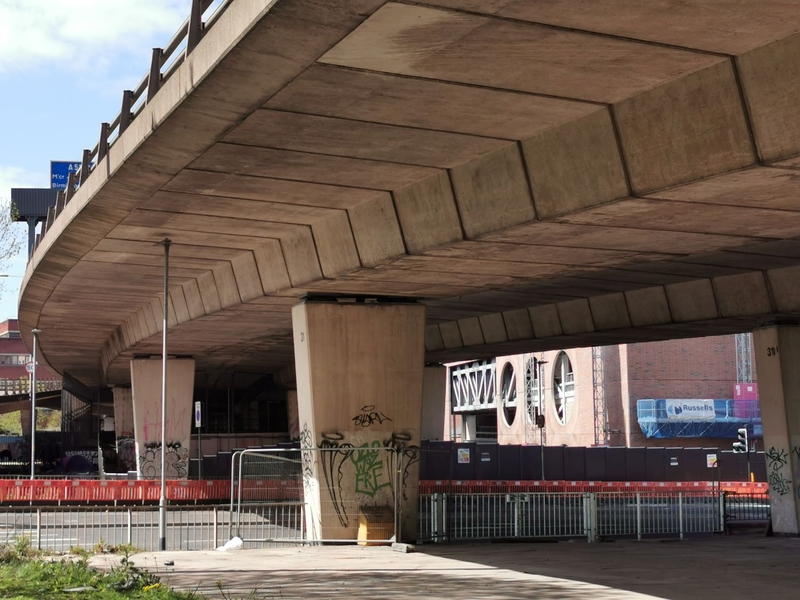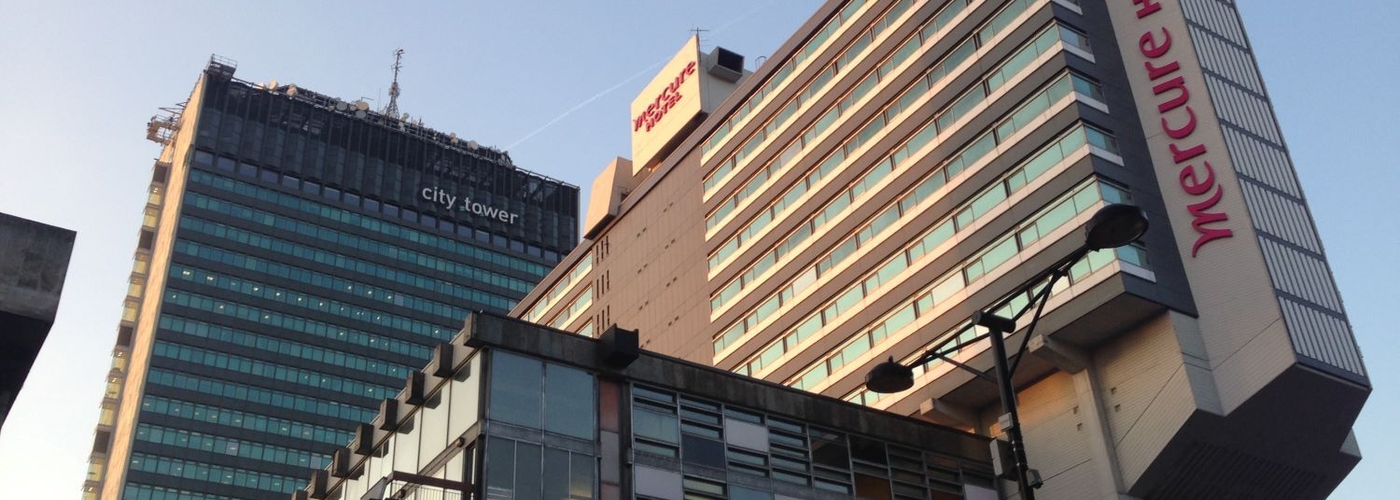Jonathan Schofield with part one of three stories about the most controversial design style
This is the first in a series of articles where we'll look at the best, in our opinion, of the various architectural styles of Greater Manchester. We start with the most controversial style of all, Brutalism. This is part one.
What is Brutalism?
Brutalism has been back for ten years at least as something to admire. During that ten years it's been making a lot of noise in the cultural world.
Greater Manchester has examples of excellent Brutalism from the sixties and early seventies and there have even been recent examples. This series of three looks at Confidentials.com's best twelve. There'll be an overall Greater Manchester winner at the conclusion of the series - and, spoiler alert, it won't be in the city centre.
So what is Brutalism? It was an ideological architecture created by intellectuals as an intellectual reaction to bombastic early twentieth century architecture which had also been created by intellectuals. Plus ça change, plus c'est la même chose.
Brutalism is a doctrine, a decision for architecture not to be pretty or gracious or gentle or pay attention to what is around and about. Usually it's a like a painting by JMW Turner: don't get up close, you'll lose the big picture, admire it from a distance.
Brutalism and its architects wanted to show how the building was made and what it was made from. Architects of the day called this 'honesty', many thought it 'anti-bourgeois'. Most non-specialists called it 'crap', or 'ugly', or 'rubbish'. Or even 'cheap', which is often why local planning departments loved it.
Brutalism is a doctrine, a decision for architecture not to be pretty or gracious or gentle
The word Brutalism derives from a delicious irony. It comes from Béton brut. This is French for raw concrete. To quote: 'The concrete is left unfinished or roughly-finished after casting and it remains exposed visually. The final surface often shows the forms and structures of the moulds into which the concrete was poured.'
Brut = raw = a brand of aftershave. Spin 'brut' into English, twist it and you get Brutalism which fits the style so well, given how it was viewed by so many.
The even bigger irony was Brutalism was frequently used in social buildings, university campuses, civic buildings, hospitals and so on. From the very beginning these buildings were derided by the population for whom they were generally intended. Architects seemed aghast that people couldn't understand the theoretical basis of the architecture but yearned for intricate decoration, curlicues, prettiness, traditional forms.
Yet there is a grandeur about Brutalism, there is an ethos, an idea that architecture should be more democratic and fit for the age and the technologies available. It's an idea that architecture should be bold. It's a style that in many ways is admirable, heroic.
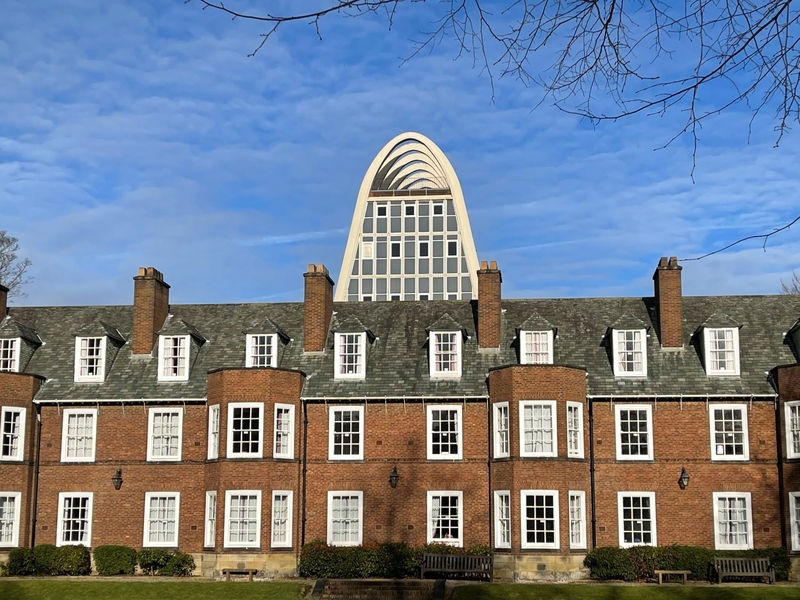
It's no coincidence that Brutalism strikes a chord with a certain section of mainly middle-class and public sector commentators. This explains why it has been praised more frequently in the pages of The Guardian in the last decade than in any other newspaper. Oliver Wainwright is a typical defender of Brutalism.
For many on the left (and I generalise grotesquely); those people who collect Brompton bikes, do urban sketching, drink rare teas and who think if you repeat the word 'progressive' you must, ergo, be 'progressive'; Brutalism represents exactly what they want it to represent, an ordered world with an underlying morality.
These structures and buildings appear to recall a time when architecture seemed aligned to a principle, a message particularly in public buildings of an aspiration for collective good rather than neo-liberal opportunism.
The examples that remain in Greater Manchester often do so because they were or have been too big to destroy, although this is not always the case: some enlightened developers such as Manchester's Bruntwood work hard to reuse and repurpose sixties and seventies buildings.
Manchester is a mish mash of architectural styles and Brutalism playss a part in delivering this entertaining streetscene.
The first four in the list (part 1/3)
Piccadilly Plaza
Date: 1959-65. Architect: Covell, Matthews and Partners
Ages ago I interviewed PJ Bell, musician and entrepreneur, who started the first jazz club on the site that now hosts Matt and Phreds. He recalled how back in the early sixties, the Plaza complex, “was like the future being built in front of you. It seemed clean and bold after the gloom of the post-war years, like something you might find in Chicago.”
The vast, utterly brutal Piccadilly Plaza quickly moved from exciting the Manchester public to annoying them as the upkeep of the vast structure lapsed and the concrete became increasingly stained.
It was a truly monumental project, of three vertical elements, the skyscraper, the hotel, and the office block laid out on a huge podium incorporating a shopping centre. Some said this was a nod to the trinity of Manchester Town Hall, the Town Hall Extension and Central Library a little way down Mosley Street.
As one architectural guide puts it: ‘The group, instead of reading together, has always looked desperately disparate. It completely fails to take account of its surroundings, but the sheer confidence and scale impress.’
They still do. The view of the hotel from Minshull Street is impressive. This is as pure Brutalism as you can get, especially that huge thrusting concrete forehead aggressively butting Portland Street. This could have been the inspiration for Ridley Scotts' Alien in the eponymous movie. Everything is supposed to look primitive, basic, obvious, with beams and posts that would feel at home on ancient temple.
There's pop coloured glass in the thin rectangulatr windows, crazy decoration on the conjoined City Tower of circuit-boards from William Mitchell, who in the interior of the hotel created an even crazier mural made of bottle-tops and a broken piano across four floors.
Best architectural story? Modernist and acclaimed US architect Louis Kahn (aged 72) was being driven up the spiral ramp of the hotel to the first floor car park by Manchester academic John Bishop in 1972. The car broke down. Behind was a van full of helpful young men who helped push the car up the ramp. While checking in the receptionist said: ‘Do you know who just pushed your car up the ramp? The Commodores!’
Piccadilly Plaza: Once, twice, three times a lump of concrete.
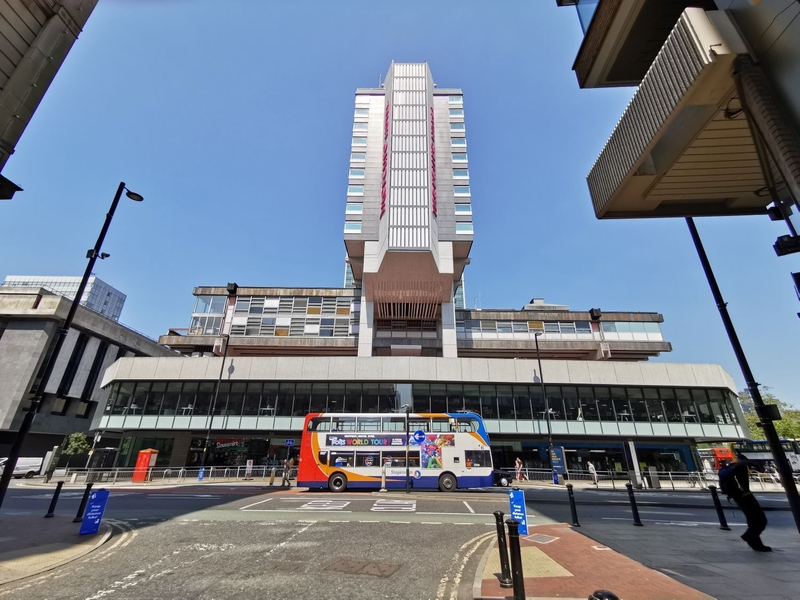
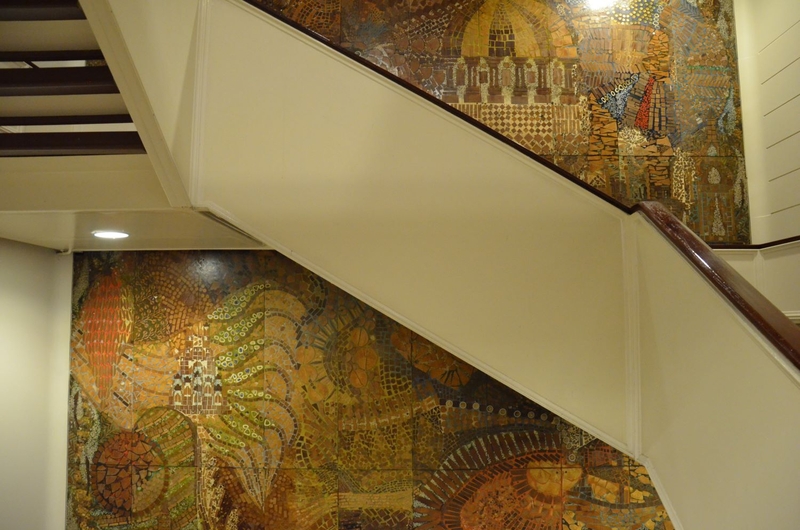
Three 'Aztec' giants, a city wall and a dead fountain
Date: various. Artists: see below
Three for the price of one here. Brutalism often saw itself as a synthesis of all the arts with reliefs, sculptures, murals.
This is where we come to the eccentric William Mitchell. We've already met him with the Piccadilly Hotel above, but the three most dramatic Brutalist beasts in Greater Manchester glower on passersbys at the University of Salford. The totem-like figures are Grade II listed.
We've written about these before and this still stands: 'At first sight they seem as dated as footage from Woodstock with beads, mini-skirts and headbands. But get up close again, walk around them, peep into their nooks and crannies, rub your hands over their folds and bulges, and there’s a certain sensual attractive horror to them. Mitchell deliberately mixed up the colour scheme, the types of concrete and even included bits of mosaic. He was a bugger though in offering no interpretation of what they might mean although we know he was having an 'Aztec moment'?'
He was bullish too. At the 1965 unveiling Mitchell spoke for 90 minutes and he was prepared for a fight. Some students it seemed were going to criticise his creations so upfront he offered this observation: "If I'm offered broadsides I'm going to slay you."
Meanwhile at UMIST campus, now part of the ID development by Bruntwood and the University of Manchester is Tony Holloway's weird concrete wall. This was designed as sound buffer for the adjacent Chemical Engineering Pilot Plant by Harry S. Fairhurst. Holloway, who also designed the stained glass at the western end of Manchester Cathedral produced something here so strange and odd, it makes you stop in your tracks and think, "You what?"
Finally, perhaps one of the best Brutalist fountains ever designed was John McCarthy's 1963 watery concrete screen leading to New Century House and Hall for the Cooperative Wholesale Society. It's been a dead thing for years, ever since the Coop lost all sense of pride with regard to this magnificent sixties complex. The wrong colour concrete planters have been jammed into the pool area and the whole thing is a mess that needs sorting by new owners Hermes, although the blame lies with the Coop.

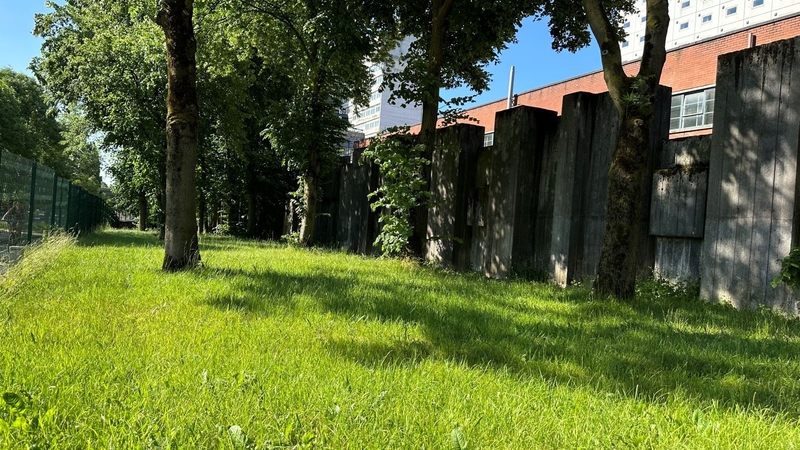
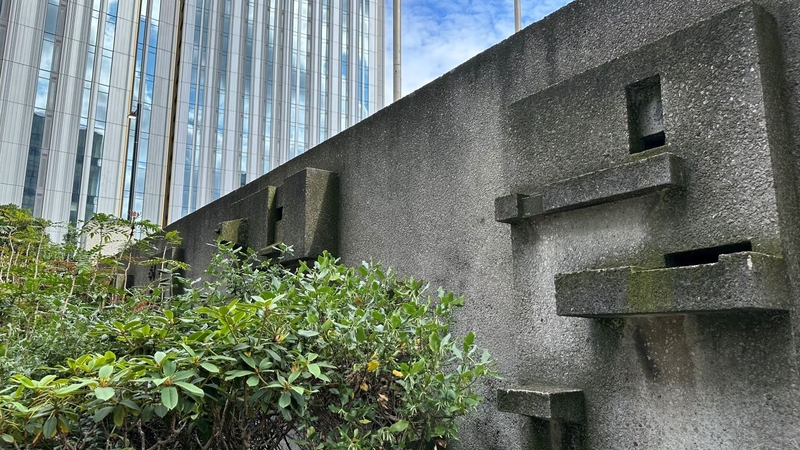
St Augustine's, All Saints
Date: 1967-8. Architects: Desmond Williams & Associates. Artist: Robert Brumby
Is it really Brutalist?
There's no concrete involved but the way this Roman Catholic church jars with everything nearby qualifies it to be defined Brutalist. The exterior is fortress-like, faced with dark brick that is not natural to Manchester and comes complete with windows which resemble long arrow-slits. The addition of modern shuttering on the doors when the church is closed adds to the forebidding, unpretty, even ugly exterior.
The interior is different. It's amazing, part of a unified structure of architecture and art. It's still all dark brick but the absolutely extraordinary Christ in Majesty by Robert Brumby takes the breath away. You don't have to be religious to gasp at the power of the attentuated figure risen from the grave which is also unpretty and perhaps even ugly but always impressive. The mural is fashioned from ceramic and is hard as the nails that were driven through Christ's limbs. The interior shows again how Brutalism delighted in the use of various materials, the windows, for instance, have coloured glass chips.
This church replaced one bombed flat in 1940 which resulted in the deaths of two priests. Another Robert Brumby work is a cross fashioned from the sacred vessels of the church which were crushed in the Nazi raid. It's another incredibly powerful work by this little appreciated artist.
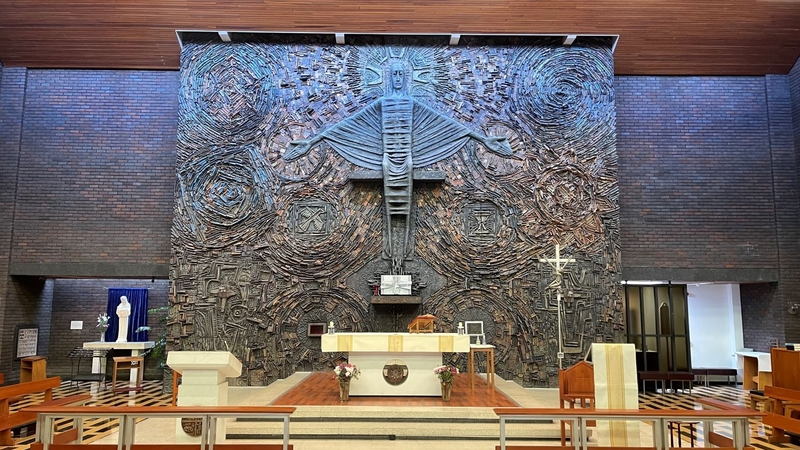
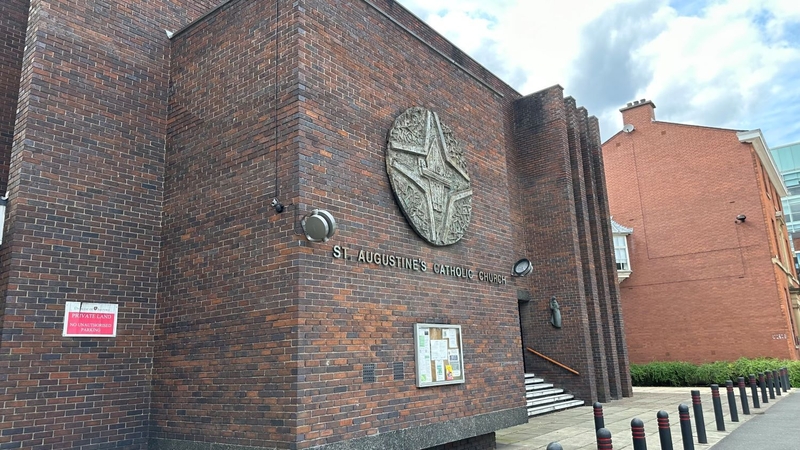
Mancunian Way
Date: 1967. Designers: G Maunsell & Partners
The Mancunian Way is a Brutalist classic in many ways. It smashed through two miles of south central Manchester careless of anything which lay in its way, houses, workshops, schools, churches had to go, because the car was the future, a liberation for the individual and a gift to personal freedom. The Mancunian Way is a concrete warrior fighting the good fight and slaying any old smoke-blackened structures of the past. It's the biggest lump of 1960s concrete poured in the city.
Prime Minister Harold Wilson officially opened the inner-motorway on 5 May, 1967. There's a paint-daubed plaque on one of the piers at the Cambridge Street roundabout and subways marking this event.
The year before another Brutalist structure, the National Computing Centre, had opened which followed on from Wilson's speech which became famous for the phrase 'the white heat of technology' (although he never actually used those exact words). The National Computing Centre would be in this list but it's appearance has been substantially altered. The architects were Cruikshank and Seward who were behind so much of the UMIST campus and the Renolds Building which is on this list and will feature later.

